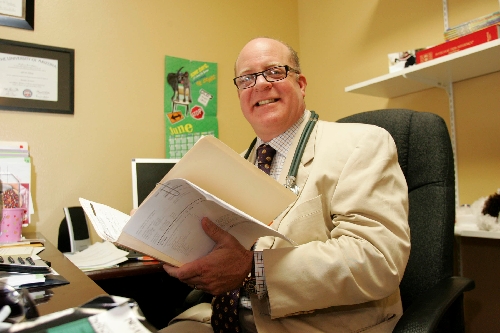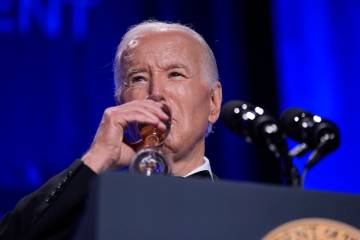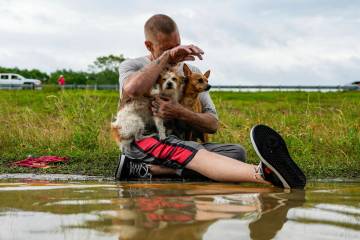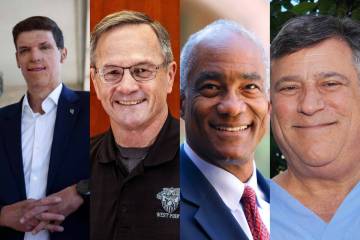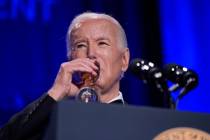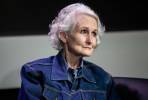Mother’s death puts lawsuit limits on line
Dr. Ivan Goldsmith walks through his offices off Tropicana Avenue and Rainbow Boulevard and talks about the future.
He is, at turns, upbeat and downcast.
He is upbeat because he'll soon be moving his practice closer to the Strip, where he believes his weight-control concepts will attract more out-of-town patients.
He is downcast because he believes a lawsuit involving a hospital and another doctor could force him and other physicians in Las Vegas to pay much higher medical malpractice premiums.
"I think this move near the Palms is really going to be a positive," he said recently. "But if I have to double my malpractice insurance because of this lawsuit, I'll probably have to leave town. A lot of doctors will be hurt."
What has Goldsmith and other Nevada doctors worried is the possibility that the state Supreme Court could overturn a law limiting the amount of damages paid out in medical malpractice cases.
The Nevada Supreme Court is being asked to consider a 2008 lawsuit brought against Spring Valley Hospital and Dr. Mahmud A. Sheikh on behalf of the family of the late Adeline Villegas.
What the case means depends on whom you to talk to.
For some, the lawsuit could promote fairness for victims of medical malpractice, opening the doors to potentially millions of dollars in redress.
To others, it is a legal action that could unfairly result in higher malpractice insurance rates for all physicians, again forcing the Las Vegas Valley to face the prospect of medical practitioners saying they're going to leave Nevada to practice in states with lower malpractice insurance rates.
Nowhere in the lawsuit does Dr. Dipak Desai's name come up.
Yet many doctors worry that felony criminal charges against the physician -- a subject of federal, state and local investigations related to the 2008 hepatitis C outbreak that affected thousands of Southern Nevadans -- have managed to so tarnish the medical profession in the public eye that it will be difficult even for a judiciary striving for objectivity to view physicians sympathetically.
"I would venture to say, when you hear about all the people hurt in that hepatitis C tragedy, that it's impossible not to be moved by what so many people have gone through and are going through," Goldsmith said. "People want to be sure victims have recourse. But I fear with this lawsuit the pendulum could swing way too far the other way. And then you have malpractice insurance rates so high that it doesn't make sense for doctors to practice."
What attorney Peter Wetherall has asked the Nevada Supreme Court to do is interpret a state statute that limits noneconomic damages -- damages for pain and suffering -- in medical malpractice cases:
"In an action for injury or death against a provider of health care based upon professional negligence, the injured plaintiff may recover noneconomic damages, but the amount of noneconomic damages awarded in such an action must not exceed $350,000."
Six years have passed since voters overwhelmingly approved Question 3 on the 2004 ballot, a measure that doctors, who lobbied hard for its passage, called Keep Our Doctors In Nevada. Desai was the biggest single financial backer of the legislation, donating $25,000.
Does the statute mean, as Wetherall suggests, that in a case involving pain and suffering there can be more than one claimant and more than one defendant? Or does it mean, as medical practitioners argue, that the law means that noneconomic damages are capped at a total of $350,000 per event?
The difference between the two interpretations literally could mean millions of dollars.
Consider the case Wetherall has brought on behalf of the family of Villegas, who the lawyer alleges died in 2007 after being misdiagnosed by Sheikh and then left untreated by Spring Valley Hospital staff.
If Wetherall's interpretation of the state statute is correct, the Villegas family estate and seven surviving members -- her husband and six children -- would each have a separate claim or action against both the doctor and the hospital.
That could mean a potential damage award for pain and suffering of $5.6 million, a far cry from the $350,000 defense attorneys say can be awarded.
If the high court should rule, however, that the 2004 state law does cap pain and suffering at a total of $350,000 per event, Wetherall has petitioned the justices to then find the law unconstitutional, arguing that it violates the equal protection guarantees of the Nevada and United States constitutions.
As many as 30 states, including Nevada, have enacted caps since 1975 in an effort to keep malpractice insurance lower for physicians. But laws restricting malpractice damages for pain and suffering have been struck down in several states, including Illinois and Georgia last spring.
In finding caps unconstitutional in its April ruling, the Georgia Supreme Court, agreeing with a woman who was disfigured in a botched plastic surgery, wrote that caps take away a jury's fundamental role in determining damages.
"The very existence of the caps, in any amount is violative of the right to trial by jury," the Georgia high court found.
The chance that Nevada's malpractice law could be overturned by Wetherall's case has so unnerved the medical establishment that the Keep Our Doctors in Nevada coalition of physicians has swung back into action. The coalition is joining with the Nevada State Medical Association, Clark County Medical Society, Nevada Hospital Association, Southern Nevada Medical Industry Coalition, Nevada Healthcare Professionals Coalition, St. Rose Dominican Hospitals, IASIS Healthcare, Nevada Insurance Council, Las Vegas Chamber of Commerce, Reno Sparks Chamber of Commerce, Henderson Chamber of Commerce and the Hospital Corporation of America in asking the high court for permission to file briefs against Wetherall's interpretation of the law.
"I expect that given the gravity and seriousness of this case, permission will be granted," Wetherall said.
So does Kirby Wells, a Las Vegas attorney representing the Hospital Corporation of America, the nation's largest hospital chain, which includes the four hospitals that constitute the Sunrise Health System in Las Vegas.
"This is a very important case when it comes to public policy," Wells said.
He believes all Nevadans who voted on the statute realized that the law would cap damages for pain and suffering at a total of $350,000 per event.
Wetherall made his request for a ruling on the 2004 statute by the high court before his case, which had been filed in Clark County District Court, actually went to trial. During early motions in the lawsuit, District Court Judge Stefany Miley ruled that the law establishes a single "applicable damage cap for All Plaintiffs and ALL Defendants."
"It didn't make sense to me to go to trial when that issue is not resolved," Wetherall said. "We have district courts going both ways on this issue, and it's hard to know how to advise clients and what cases we should take to court."
In his April petition where he asks the high court to intervene, Wetherall noted within two weeks of Miley's ruling another District Court judge, Mark Denton, ruled in a malpractice case that each plaintiff had a separate cause of action.
The state Supreme Court could have denied Wetherall's petition outright, but instead asked for briefs from parties in the case.
"The high court opened the door to getting to the merits of the law," he said.
In a response to the Supreme Court's request for briefs on the meaning of the law, attorneys representing Spring Valley Hospital called Wetherall's petition to the court a "veiled attempt to circumvent the will of the Nevada voters and revert back to the damages limitation" in an earlier statute that was repealed by passage of the 2004 statute.
But hospital attorneys favor the high court issuing a ruling on the law.
"We're not fighting that (the high court looking at the issue)," said Sarah Harmon, an attorney for the Valley Health System, which includes Spring Valley Hospital.
Robert McBride, an attorney for Sheikh, the physician sued in the case, wouldn't comment on any issue involving his client.
Wells said while all attorneys in the case expect the high court to rule on the statute, no one is sure just when. "They could ask for oral arguments as well. A ruling may not come down this year."
There have been conflicting opinions on how well the malpractice reform law is working since it went into effect on Nov. 24, 2004.
Doctors, who have realized 20 percent to 30 percent savings on malpractice insurance, love it. So do insurance executives, whose companies profit by not having to make large payouts.
Attorneys, who believe a potentially lucrative part of their business is cut off, hate it.
Some Nevadans, including 61-year-old Richard Krikalo, who says a botched retina reattachment procedure in 2007 left him nearly blind in his right eye, believe the law now makes it far too difficult for an individual to get compensated when doctors make mistakes.
He said attorneys told him that the caps made it "economically unfeasible" for them to take his case. When he finally found a lawyer who said he might take his case, the attorney noted that time had run out to file it.
As part of the reform law, the Legislature had enacted a one-year time restraint on filing malpractice claims compared with the previous two-year deadline.
Recovery of economic damages, including loss of future earnings and medical expenses, still remains part of Nevada malpractice law. According to attorneys, that leaves potential plaintiffs by the wayside. Homemakers, children, seniors and people such as Krikalo, who are still able to work despite injury, have no loss of future earnings to calculate. Basically, these malpractice awards would come out of the $350,000 allocated to pain and suffering, a sum divvied up between the attorney and the client.
Before the reform, juries would sometimes award seven-figure judgments for pain and suffering to grieving parents who lost a child to medical negligence or to an individual whose quality of life had changed because of a physician's mistake.
Jim Crockett, an attorney who quit practicing in the medical practice arena after the reforms went into effect, said it no longer made sense for him to take cases. His cases centered on the wrongful death of children, housewives and senior citizens.
The cost of hiring experts to prove malpractice is high, Crockett said.
The final outcome of cases wasn't satisfactory for either the client or him.
"If a client gets a little more than $50,000 after four years of stressful litigation, they don't feel it's worth it," he said.
Ryan Erwin, a strategic adviser in the Keep Our Doctors in Nevada campaign, said physicians have long believed that trial lawyers abuse the system, filing frivolous malpractice claims and hoping for settlements and unrealistic jury awards.
"There are bad doctors out there, but is it right to punish an entire industry for a what few do?" he said. "You don't want to throw the baby out with the bath water. If you don't cap the process, we won't have any specialists left in Nevada. The malpractice rates will just be too high."
Dr. Ron Kline, head of the Nevada State Medical Association, said there is no doubt that caps have lowered malpractice insurance premiums and kept doctors in Nevada.
"We had a lot of doctors leaving before the law went into effect," he said.
No one knows how many doctors really left Nevada before the law went into effect. The nation's General Accountability Office couldn't reach a figure and deemed the ever-changing statistics cited by Nevada physicians to be anecdotal, exaggerated and inaccurate.
According to studies by Medicare and Medical Economics, physicians spend between 3.2 percent and 3.9 percent of the income from their practices on malpractice insurance.
Erwin points out that the Nevada reform law was modeled on the California statute, which was enacted in 1975.
Andrew LaMar, a spokesman for the California Medical Association, said that state's $250,000 cap on pain and suffering "has stood the test of time."
"Those who have challenged its constitutionality have lost," he said.
It is no secret that trial attorneys have been trying to find the right case to try and overturn the Nevada statute ever since it was enacted.
"Often we'll have what we believe is a good case, but then the other side wants to settle," said Gerald Gillock, an attorney who litigates medical malpractice cases. "I've always believed the law was unconstitutional."
Wetherall said the family of the late Adeline Villegas doesn't want to settle the case.
When three of her six adult children showed up to confer with Wetherall recently, her son Alvin was adamant: "Mom would be proud of us sticking up for her and ourselves."
The lawsuit brought by the family alleges that Adeline Villegas, 65, was misdiagnosed with pancreatitis by Sheikh shortly after she was transferred from Southern Hills Hospital to Spring Valley Hospital on Aug. 6, 2007. The lawsuit also alleges that she was left untreated by hospital staff and Sheikh, dying on Aug. 8, 2007, of a ruptured ulcer and peritonitis.
In court documents, attorneys for both the hospital and Sheikh deny any liability for the death.
"This was a woman who was in good health otherwise," Wetherall said. "And now a husband can't enjoy his retirement years with his wife, and her children and grandchildren are robbed of her affection. The pain and suffering here are very legitimate."
Wetherall said even if the Supreme Court decided to rule on the cap, it is important to remember that the malpractice case itself will still have to be litigated. "Obviously, I think we have a good case," he said.
As Goldsmith sat in his office, he said he wouldn't want to bet on how the Nevada Supreme Court will rule on the Villegas case regarding the cap on pain and suffering. But he said one thing is a sure bet:
"No matter what side you're on, this case could change once and for all the way both medicine and law are practiced in Las Vegas."
Contact reporter Paul Harasim at
pharasim@reviewjournal.com or 702-387-2908.





